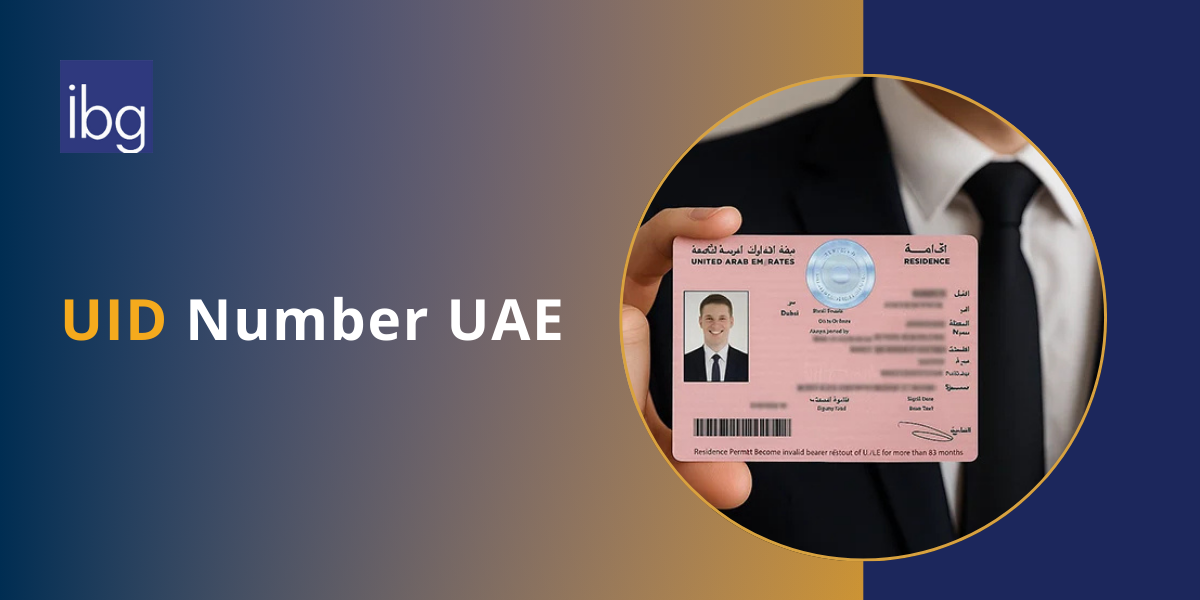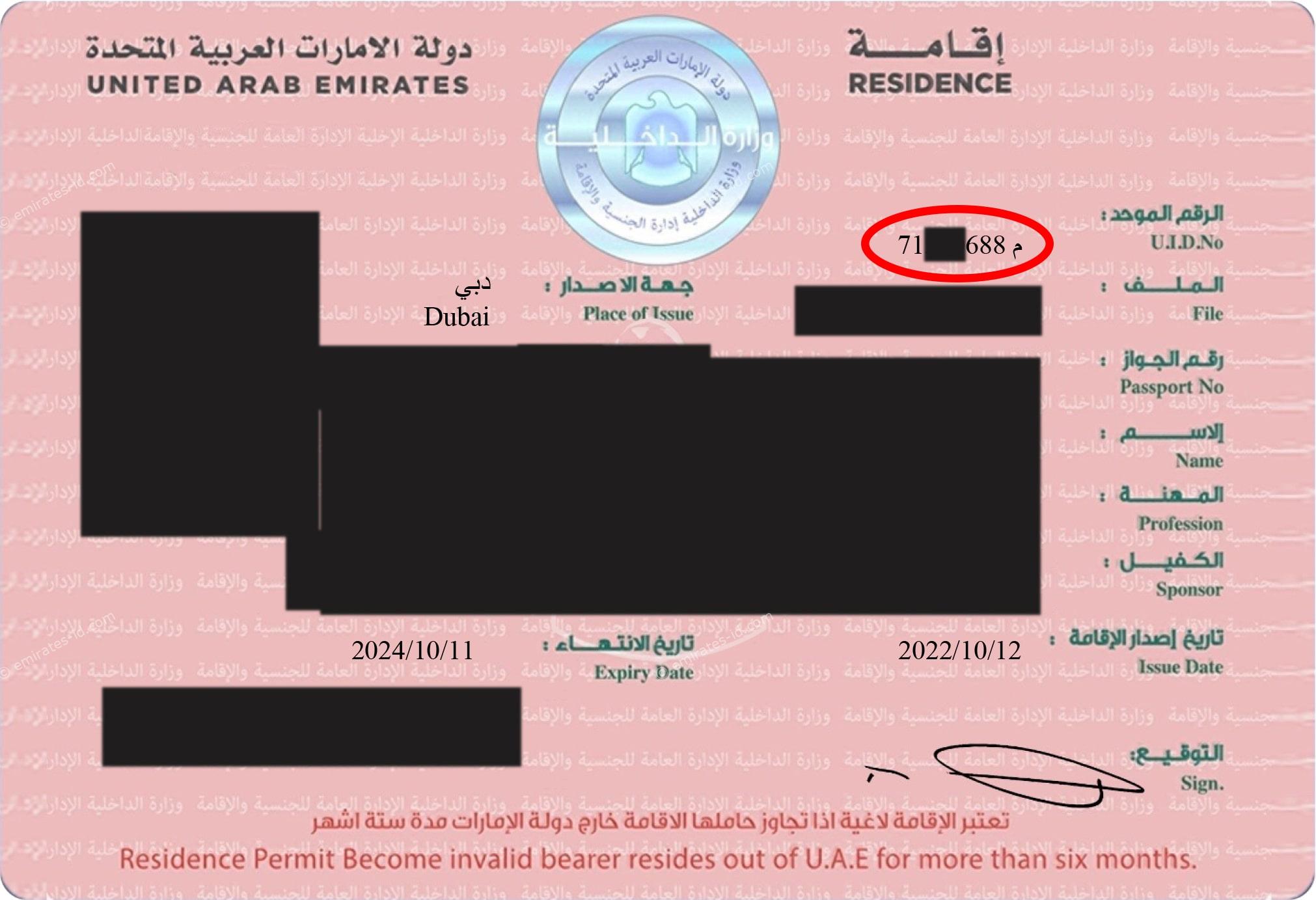
Guide to Unified Number in the UAE – UID Number
A Unified Identification Number (UID) is a system of numbers used in the United Arab Emirates (UAE) for identification purposes. It’s a unique set of numbers that’s allotted to you during your residence visa process. It’s printed on your visa document and the Emirates ID.
This guide walks you through everything you need to know about the unified number in the United Arab Emirates, including its definition, utility, importance, process, and regulations. It will ensure you understand the UID number and shouldn’t face any complications with it.
What is a Unified Number in the UAE?
In simplest terms, it’s a unique number for individual identification. The unified number is a 9 to 15-digit number used in the UAE. From resident and immigration identification to tracking, it serves many purposes. It’s very relevant and important for all individuals.
The following two government bodies are responsible for issuing this number:
- General Directorate of Residency and Foreign Affairs (GDRFA)
- Federal Authority for Identity and Citizenship (ICA)
Generally, you do not have to apply for it. It’s allotted to you automatically during your visa application. After the number is issued, it is important to understand the unified number. It is linked to many personal documents such as Emirates ID, driving license, visa, business records, and work permit.
What is the Use of the UID Number in the UAE?
The major purpose of the UID number is identity provision and data storage. The government allocates a number to each individual through which they can easily track their data and keep all details in one place.
The following are a few more aspects of the UID number’s utility:
One Number for All Your Records: Your UID holds all your records. Plus, it stays the same, even if you get a new visa or change jobs.
Needed for Multiple Processes: UID is necessary to complete your UAE residency visa steps. It is also required when applying for your Emirates ID and doing a medical test.
Used by Government Offices: Government departments use your UID to check your visa, work details, or background. It helps them share your information safely.
Helps with Visa Changes: If you change your job or renew your visa, your UID helps make the process easier. It connects your old and new visa records without problems.
Important for Security: The UAE uses the UID to check for any legal or criminal issues. It helps keep the country safe and checks if someone is on a watchlist.
Works for All Types of Visas: Whether you’re coming as a tourist, worker, student, or family member, you’ll get a UID. It will be used if you come back again later, too.
Significance of the Structure in Unified Number UAE
The structuring of the numbers in the UID is important. It’s systemized to be unique for each individual. Here’s a breakdown of the structure:
First 3 Digits: Emirate Code
The first three digits identify the issuing emirate. This helps instantly link the UID to the regional immigration authority. The following is the classification:
- 101 – Abu Dhabi
- 201 – Dubai
- 301 – Sharjah
- 401 – Ajman
- 501 – Umm Al Quwain
- 601 – Ras Al Khaimah
- 701 – Fujairah
Next 4 Digits: Year of Issue
The following four digits are the year the visa was issued (e.g., “2025”). This lets the system track visa issuance years.
Last 7 – 9 Digits: Visa Serial Number
The final digits correspond to the individual’s residence visa number or file number. This is supposed to uniquely identify that visa holder.
How to Get UID Number During Residence Visa Process?
1. Enter the UAE Through a Valid Visa
Enter the United Arab Emirates with a valid visa. It could be a tourist visa, a green visa, a golden visa, or any other type. Ensure its validity and enter the UAE.
2. Submit Entry Permit at Immigration
As you enter the UAE, you will have to submit your entry permit to the immigration officer for approval. The UID number is generated at this point.
3. Receive Visa Sticker or Entry Document
As your entry is approved and you receive your documents, the UID number will be printed on your visa or permit. It’s usually located on the upper section of the document.
4. Verify UID Online (Optional)
You can visit the GDRFA online website, provide your personal details, and they will confirm your UID number. This step is completely optional.
5. Contact Immigration Authority if Not Issued
In case you don’t find your UID number on any documents or online, you can consult the immigration authority. Report your issue, and they will have it resolved.
6. Use UID for Emirates ID and Residency Procedures
The UID becomes your personal reference in all government records. It is needed when applying for an Emirates ID, a medical test, or any immigration process. Even after these processes, the UID number remains vital throughout your stay in the UAE.
How to Find your UID Number?
The UID number is printed on your visa papers and the Emirates ID. If you need to find it, there are several ways. You can resort to the next if, for some reason, the first doesn’t work for you.
1. Check the UID Number on the Emirates ID
The UID number is listed on the top right of your Emirates ID and UAE visa. Find your Emirates ID and note the numbers listed under the heading “U.I.D No”.

2. Check the UID Number Online
Visit the GDRFA website and find the Unified Number Inquiry Service portal. Submit your details like nationality, date of birth, and gender. Process the security verification and press “submit”. The algorithm will match your details and show your UID number on the screen. It’s a safe and reliable method to retrieve your UID number without your Emirates ID.
3. Inquire from the Authorities
If the online forum is inaccessible, you can either contact the authorities via phone or visit their office in person. Talk to a representative, and they will help you retrieve your UID number. The following are their phone numbers:
- For UAE Residents: 8005111
- For International Calls: +971 4 313 9999
UID vs Emirates ID Number vs UAE Visa Number
Since it is very natural to confuse the utility and significance of different numbers given to you during your residency in the UAE, this table helps you understand the purpose and use of each:
| Type of Number | Purpose | Where to Find It | Who Gets It |
| UID Number | Unique ID from immigration used for all visa and identity processes | Entry permit, visa page, ICP/GDRFA portals | All visa holders (visit or resident) |
| Emirates ID Number | Personal ID number for all official, legal, and government services | On the Emirates ID card | UAE residents and citizens |
| Residence File Number | Tracks residency visa file and sponsorship | On visa page in passport (starts with 101, 201, etc.) | Only residency visa holders |
| Visa Number | Specific to each visa issued, tracks visa type and validity | On visa sticker or e-visa copy | Visit, work, and residence visa holders |
Solution to Multiple UID Numbers
Sometimes, due to processing errors, an individual may be allotted multiple UID numbers in UAE. Given that the UID number is essential during your stay, such issues must be resolved. You can follow this step-by-step method to solve the multiple UID number issue smoothly:
Step 1: Visit the nearest GDRFA office.
Step 2: Submit the request to merge the UID numbers linked to you.
Step 3: Provide the required details, documents, and pay the fee.
Step 4: Wait while the authorities process your application.
Step 5: After successful processing, you will receive your merged UID number.
You can always contact the regulatory bodies like GDRFA and ICA if you run into any such complications, and count on them to solve those.
Frequently Asked Questions (FAQs)
1. What role does my passport number play in accessing services in the UAE?
Your passport number is crucial for checking records linked to residency, legal status, and even for confirming your visa status online. When dealing with various services in the UAE, government systems use it as a key reference, especially when verifying entry and residence.
2. How do I check my UID Number UAE details online using GDRFA?
You can access your residency file by visiting the official GDRFA platform. This is where you can input your passport number and birth date to retrieve important details. It’s an easy way to confirm information related to living in the UAE or starting a business in the UAE.
3. Can UAE residents check their visa status without their document?
Yes. Residents can check their UID number online using their passport, email address, and personal data through approved portals. This is especially useful when physical documents are lost or inaccessible.
4. Where exactly can I locate my UAE residency info?
You can find it printed on the upper section of your permit, right above the number of file, and below the UID. These figures are essential for those planning business setup in Dubai or accessing government support services.
5. Why is it important to track my number in UAE government systems?
Tracking this number helps maintain smooth interactions with the government of UAE portals. It ensures you’re recognized when accessing education, healthcare, or services in UAE as a resident, entrepreneur, or visitor.
6. Can having more than one record number cause problems?
Yes. Sometimes, due to system overlap, multiple UID numbers may be issued to the same person. This can create confusion in immigration files and delay legal processes. You should request a merge if this happens.
7. What should I know about the number linked to my permit?
This code, located above your UAE visa, plays a major role in managing your profile in public systems. It stays constant, even if your job or residence status changes, and helps you access everything from banking to housing.
8. How is this number relevant for business in the UAE?
Whether you’re applying for a trade license or registering a company, having the correct government-issued code is essential. It verifies your legal standing, allowing for easier business setup in Dubai and access to incentives.
9. Can I retrieve this number using my email or phone?
Yes. Certain platforms let you find your UID online by verifying your email address and phone number. This is helpful for UAE residents who don’t have their physical documents on hand.
10. What do I need to know about staying long-term in the UAE?
If you plan on living in the UAE, managing a company, or simply using services in UAE, it’s crucial to understand how personal data is handled. From your number of file on your visa to residency status, there’s everything you need to know before making long-term plans.
